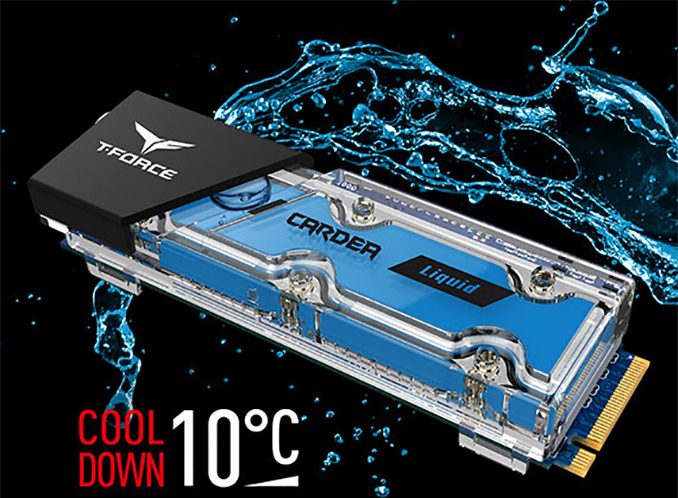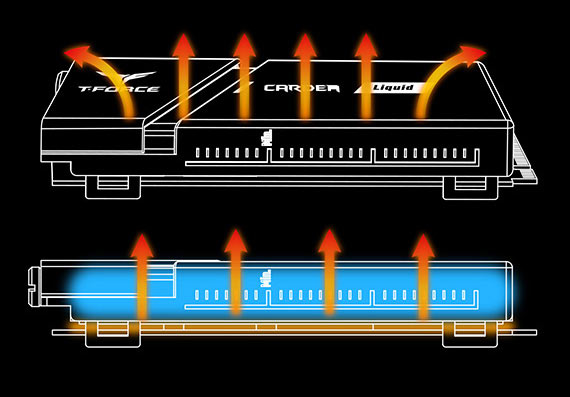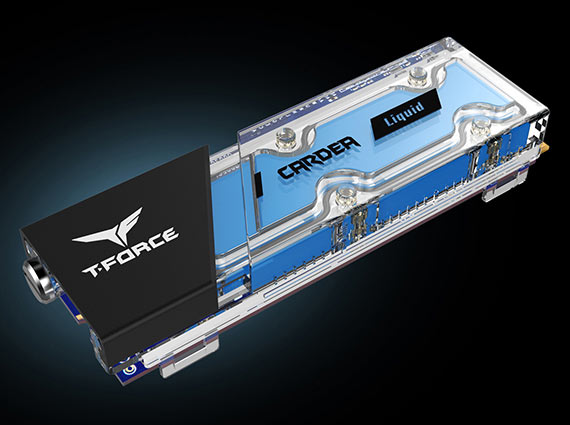Team Group’s T-Force Cardea Liquid: A Liquid-Cooled M.2 SSD
by Anton Shilov on July 26, 2019 1:00 PM EST- Posted in
- SSDs
- Storage
- M.2
- 3D TLC
- Team Group
- PS5012-E12
- T-Force Cardea Liquid

With liquid cooling options already available for most PC components, it was only a matter of time until someone did it for PC storage as well. And now that point has come, thanks to Team Group and its T-Force Cardea Liquid M.2 PCIe Gaming SSD.
True to its name, the T-Force Cardea Liquid M.2 PCIe Gaming SSD is an M.2 SSD relying on water cooling to keep its temperature in check. And while it's not a looped cooling device – despite using liquid cooling, it's still a stand-alone, closed device that doesn't get plugged in to an open loop system – it's none the less a novel step in developing more exotic SSD cooling systems. Using their liquid cooling module, Team Group says that their cooling system will reduce temperature of the drive by 10ºC when compared to a SSD without a heat sink.
The cooling system of the T-Force Cardea Liquid is relatively simple. The liquid cooling module relies on the self-circulation effect by separating the water block into two chambers. When the coolant in the chamber above the controller/memory gets hot, it flows to the second chamber to cool down. Essentially, the aluminum water block acts like a vapor chamber, but uses a mainstream coolant instead of a specialized low boiling point liquid. This kind of cooler is cheap to make, and since it is shipped without any water inside (it's designed to be filled by the end user), there is no risk of leakage during shipping. Because it's still a closed cooling system, the SSD and its cooling module still requires a good airflow inside the PC case to pull heat away and out of the system, but using a liquid to cool down a high-end SSD is certainly an innovative method.
Set to be available in 256 GB, 512 GB, and 1 TB versions, the T-Force Cardea Liquid is compatible with any desktop PC featuring an M.2-2280 slot supporting a PCIe 3.0 x4 interface. With that said, the the drive is far taller than normal SSDs at 14.1 mm high, so one has to make sure there is enough space around it to fit.
The liquid-cooled SSD from Team Group is based on Phison's PS5012-E12 controller as well as 3D TLC NAND from an undisclosed manufacturer. When it comes to performance, the top-of-the-range 1 TB model of the T-Force Cardea Liquid will offer up to 3400 MB/s sequential read speed, up to 3000 MB/s sequential write speed (when pSLC caching works), up to 450K IOPS random read speed, and up to 400K IOPS random write speed. Since this is a consumer SSD, we are talking about peak numbers here.
| Team Group T-Force Cardea Liquid M.2 PCIe SSD Specifications | |||
| Capacity | 256 GB | 512 GB | 1 TB |
| Model Number | TM8FP5256G0C119 | TM8FP5512G0C119 | TM8FP5001T0C119 |
| Controller | Phison PS5012-E12 | ||
| NAND Flash | 3D TLC NAND | ||
| Form-Factor, Interface | M.2-2280, PCIe 3.0 x4, NVMe 1.3 | ||
| Sequential Read | 3000 MB/s | 3400 MB/s | |
| Sequential Write | 1000 MB/s | 2000 MB/s | 3000 MB/s |
| Random Read IOPS | 200K IOPS | 350K IOPS | 450K IOPS |
| Random Write IOPS | 200K IOPS | 300K IOPS | 400K IOPS |
| Pseudo-SLC Caching | Supported | ||
| DRAM Buffer | ? | ||
| TCG Opal Encryption | No | ||
| Power Management | ? | ||
| Warranty | 3 years | ||
| MTBF | 2,000,000 hours | ||
| TBW | >380 TB | >800 TB | >1665 TB |
| Additional Information | Link | ||
| MSRP | ? | $100.99 | $169.99 |
Team Group will start selling its T-Force Cardea Liquid drives in the near future. Pricing is something that remains to be seen, but keep in mind that this is a high-end SSD family.
Related Reading:
- Alphacool Releases Two New SSD Coolers: Passive HDX-2 and Watercooled HDX-3
- The Team Group MP34 512GB SSD Review: Refining Phison's NVMe Workhorse
- ADATA Announces XPG Storm: A Cooler for M.2 SSDs with a 16500 RPM Fan
- CES 2019: TeamGroup And ASRock Release Phantom Gaming Branded Memory and SSD
- EKWB Launches Aftermarket EK-M.2 Aluminum Heatsink for M.2 SSDs
Source: Team Group













34 Comments
View All Comments
Arbie - Friday, July 26, 2019 - link
So we can look forward to Monster Cable RGB coolers, for the "gamer" LED arrays.FreckledTrout - Friday, July 26, 2019 - link
Just as with audiophiles the number of people that have the cash and are gullible is very low. Those two things typically do not intersect all that often. In another words they wont sell but a handful of these an most of those will be in PC's that get put on display.CheapSushi - Friday, March 5, 2021 - link
Engineers like you seem to have cool jobs but end up being the absolutely most boring people ever.satai - Friday, July 26, 2019 - link
Finally the industry found a thing more useless than water cooling. Water cooling for m.2.Congratulations! The progress can't be stopped!
Lord of the Bored - Saturday, July 27, 2019 - link
It isn't even really water-cooling. There's no radiator anywhere.It is just a heatsink that contains water. Not even a good one, since it doesn't have any fins.
Alex Topfer - Sunday, July 28, 2019 - link
There are plenty of cases where water cooling can be usefulThis isn't one of them
satai - Monday, July 29, 2019 - link
The plenty of cases is... datacenter.CheapSushi - Friday, March 5, 2021 - link
Even IBM System Z mainframes use watercooling. Geeez how useless, right?Flunk - Monday, July 29, 2019 - link
M.2 drives get really hot and can throttle because of it. Thus isn't like water-cooling RAM. This product IS worthless however because there is no way to get the heat out, making it water recirculating.vladx - Friday, July 26, 2019 - link
I believe there's a 0 missing in the 'Sequential Write' first column.